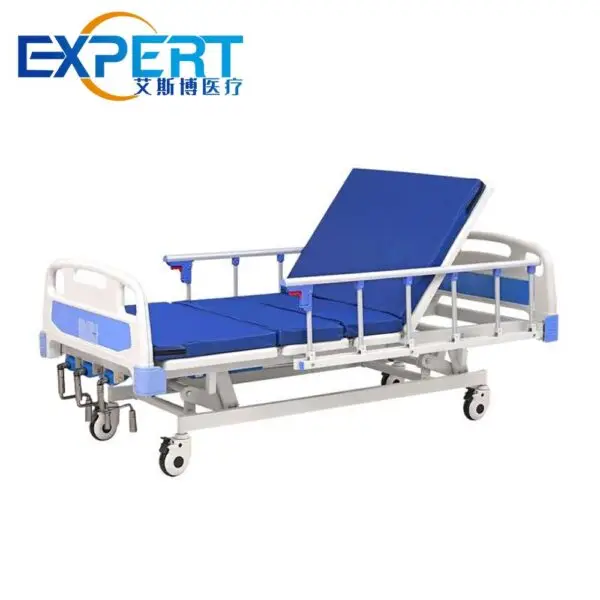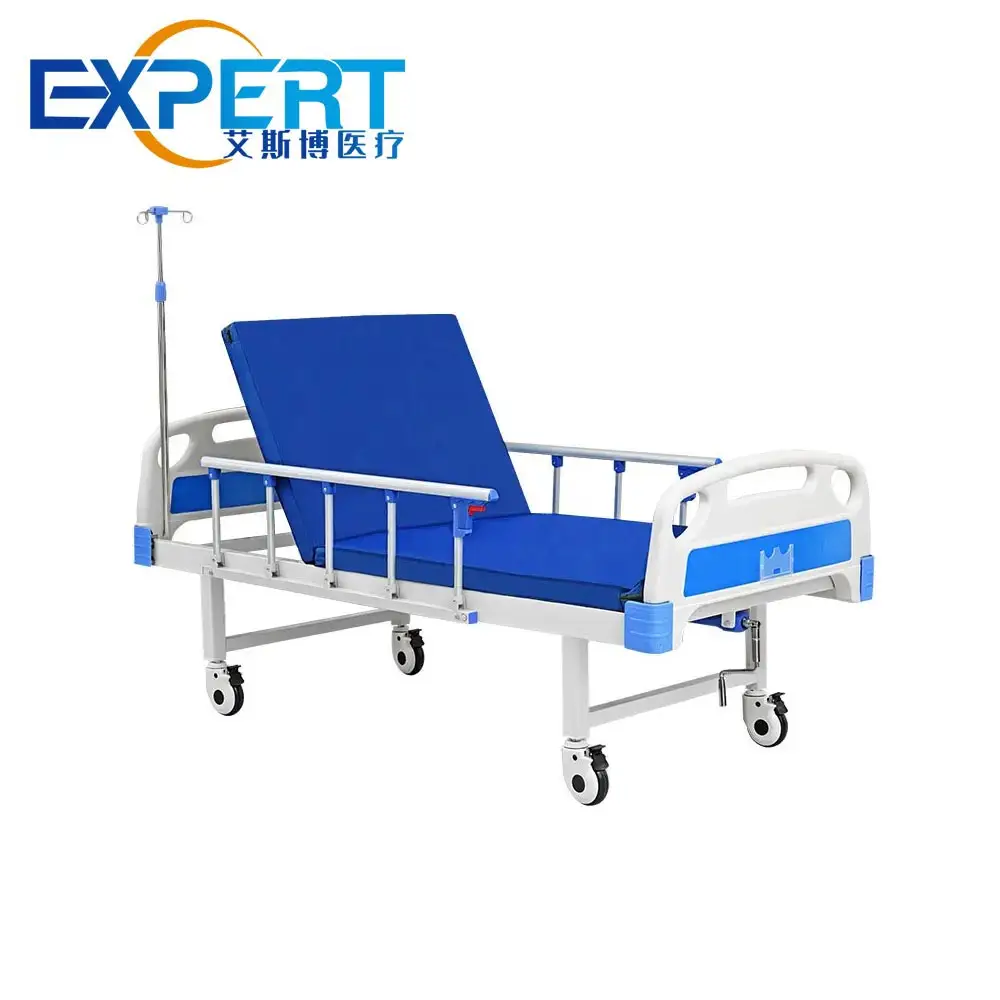Adresse
304, rue Cardinal Nord
Centre Dorchester, MA 02124
Heures de travail
Du lundi au vendredi : 7h - 19h
Week-end : 10h - 17h
Bienvenue sur mon blog !
Avant de plonger dans le contenu, j'aimerais que vous me rejoigniez sur mes plateformes de médias sociaux où je partage plus d'informations, interagis avec la communauté et publie des mises à jour. Voici comment vous pouvez me contacter :
Facebook :https://www.facebook.com/profile.php?id=100071234835011
LinkedIn :https://www.linkedin.com/company/74943205/admin/dashboard/
YouTube :https://www.youtube.com/@shandongexpertmedicalequip4695
TikTok :https://www.tiktok.com/@expertmedical
Commençons maintenant notre voyage ensemble. J'espère que vous trouverez le contenu ici instructif, engageant et utile.
En matière de soins aux patients, la sécurité est une priorité absolue, et l'un des équipements les plus importants pour y parvenir est un lit d'hôpital avec barrières latérales. Ces lits offrent confort et protection aux patients, notamment ceux à mobilité réduite ou nécessitant une aide au positionnement. Les barrières latérales assurent la stabilité, préviennent les chutes et aident le personnel soignant à déplacer et positionner les patients en toute sécurité. Dans cet article, nous explorerons le rôle d'un lit d'hôpital avec barrières latérales, ses caractéristiques de sécurité et son rôle dans le bien-être général des patients.

Un lit d'hôpital avec barrières latérales est conçu avec une série de dispositifs de sécurité qui contribuent à prévenir les accidents et à améliorer le confort du patient. Les barrières latérales, en particulier, jouent un rôle essentiel dans la prévention des chutes, un risque fréquent pour les patients à mobilité réduite. Ces lits sont particulièrement importants pour les patients âgés, les personnes en convalescence après une intervention chirurgicale ou celles souffrant de troubles affectant leurs mouvements et leur équilibre.
Les lits d'hôpitaux modernes avec barrières latérales sont dotés de plusieurs fonctionnalités visant à améliorer la sécurité des patients. Comprendre ces caractéristiques est essentiel pour choisir le lit idéal pour les soins à domicile ou à l'hôpital.
L'une des caractéristiques les plus importantes d'un lit d'hôpital avec barrières latérales est leur réglage. Ces barrières réglables permettent au personnel soignant de les relever ou de les abaisser selon les besoins, facilitant ainsi le transfert des patients vers et depuis le lit, tout en garantissant leur sécurité au repos.
Pour garantir le maintien des barrières, la plupart des lits d'hôpitaux équipés de barrières latérales sont équipés de mécanismes de verrouillage sécurisés. Ce dispositif empêche tout abaissement accidentel des barrières, susceptible d'entraîner des chutes ou des blessures.
L'un des principaux avantages d'un lit d'hôpital équipé de barrières latérales est la prévention des chutes. Les chutes sont une cause majeure de blessures dans les hôpitaux et les établissements de soins à domicile, et les barrières latérales constituent une solution simple et efficace pour minimiser ce risque. Cependant, les barrières latérales ne servent pas seulement à empêcher les patients de tomber : elles contribuent également à améliorer leur mobilité.
Pour les patients à force réduite, les barrières latérales peuvent servir d'aide au repositionnement au lit ou pour s'asseoir. Elles peuvent être particulièrement utiles pendant la rééducation ou la convalescence, permettant aux patients de retrouver force et autonomie tout en réduisant leur dépendance aux soignants.









Choisir un lit d'hôpital avec barrières latérales adapté est essentiel pour assurer la sécurité et le confort du patient. Plusieurs facteurs sont à prendre en compte, du type de barrières latérales aux caractéristiques générales du lit et à leur adéquation aux besoins du patient.
Avant d’acheter un lit d’hôpital avec barrières latérales, il est important de prendre en compte l’état du patient, l’environnement de soins et les caractéristiques qui offriront la meilleure combinaison de sécurité, de confort et de commodité.
Le type de lit et de barrières latérales que vous choisissez doit être adapté à l'état du patient. Les patients présentant un risque de chute élevé ou des problèmes de mobilité importants peuvent bénéficier de barrières latérales pleine longueur, tandis que ceux à mobilité modérée peuvent n'avoir besoin que de barrières mi-longues.
Outre les barrières latérales, pensez à la capacité de réglage du lit. De nombreux lits d'hôpitaux permettent de surélever la tête ou les pieds, ce qui peut améliorer le confort du patient et réduire les problèmes tels que les escarres ou les troubles circulatoires.

Pour vous aider à prendre votre décision, voici un tableau comparatif des modèles de lits d'hôpitaux les plus courants équipés de barrières latérales. Chaque modèle a été évalué en fonction de ses principales caractéristiques, notamment le type de barrière, la possibilité de réglage et la facilité d'utilisation.
| Modèle | Type de rail | Ajustabilité | Mécanisme de verrouillage | Idéal pour |
|---|---|---|---|---|
| Invacare entièrement électrique | Pleine longueur | Entièrement réglable | Verrouillage manuel | Patients à haut risque de chute |
| Medline Alterra 1385 | Demi-longueur | Tête et pieds réglables | Verrouillage automatique | Usage général, soins à domicile |
| Drive Medical Delta Ultra | Pleine longueur | Réglable en hauteur | Verrouillage manuel | Utilisation en milieu hospitalier et de réadaptation |
| Lit de soins Qilu modèle 90 | Demi-longueur | Tête et pieds réglables | Verrouillage automatique | Patients à mobilité modérée |
| Hill-Rom Advanta 2 | Pleine longueur | Entièrement réglable | Verrouillage manuel et automatique | Utilisation en USI et à l'hôpital |
Cette comparaison donne un aperçu rapide des différents modèles, vous aidant à identifier le lit d'hôpital avec barrières latérales adapté à vos besoins, que ce soit pour les soins à domicile ou en milieu clinique.
Un lit d'hôpital avec barrières latérales est un investissement essentiel pour assurer la sécurité et le bien-être des patients, en particulier ceux à mobilité réduite. Ces lits préviennent non seulement les chutes, mais offrent également un soutien aux patients lorsqu'ils doivent se déplacer ou se repositionner. En choisissant le bon modèle, doté des dispositifs de sécurité nécessaires, les soignants peuvent offrir un environnement plus sûr et plus confortable à leurs patients. Que ce soit à l'hôpital ou à domicile, un lit d'hôpital avec barrières latérales est un équipement essentiel qui améliore à la fois la sécurité et la qualité des soins.
Un lit d'hôpital équipé de barrières latérales offre de nombreux avantages, notamment la prévention des chutes, une aide à la mobilité et une sécurité accrue pour les patients dont la force ou la coordination est limitée. Les barrières latérales permettent également au personnel soignant de repositionner ou de transférer les patients en toute sécurité.
Bien que tous les patients n'aient pas besoin de barrières latérales, elles sont fortement recommandées pour les personnes à mobilité réduite, celles qui se remettent d'une intervention chirurgicale ou celles qui présentent un risque de chute. Les barrières latérales offrent une sécurité supplémentaire, notamment pour les personnes âgées ou handicapées.
Oui, la plupart des lits d’hôpitaux avec barrières latérales offrent des barrières réglables ou amovibles, permettant aux soignants de les abaisser en cas de besoin, par exemple lors des transferts, ou de les relever pour plus de sécurité lorsque le patient se repose.
Les barrières latérales peuvent servir de poignées de soutien, permettant aux patients de se repositionner ou de s'asseoir avec une assistance minimale. Cette fonctionnalité aide les patients à retrouver leur autonomie et allège la charge de travail des soignants.
Oui, certaines réglementations s'appliquent à l'utilisation des barrières latérales en milieu hospitalier, notamment pour garantir leur utilisation sûre et appropriée. Une utilisation excessive des barrières latérales peut entraîner des problèmes de contention ; il est donc important de les utiliser de manière responsable et pour les bonnes raisons.
Lors du choix d'un lit d'hôpital avec barrières latérales, tenez compte de la mobilité du patient, du type de soins requis, de la possibilité de réglage du lit et des barrières, ainsi que des éventuels mécanismes de verrouillage pour une sécurité accrue. Il est également important de veiller à ce que le lit soit confortable pour le patient et pratique à utiliser pour le personnel soignant.
Oui, les lits d'hôpitaux équipés de barrières latérales sont couramment utilisés dans les services de soins à domicile, notamment pour les personnes âgées ou handicapées. Les barrières latérales contribuent à la sécurité à domicile et offrent un soutien aux patients et aux soignants.
Oui, il existe différents types de barrières latérales, notamment des barrières pleine longueur et des barrières mi-longues. Les barrières pleine longueur offrent une sécurité maximale, tandis que les barrières mi-longues facilitent l'accès au patient et conviennent mieux aux personnes n'ayant pas besoin d'une contention constante.
Les barrières latérales créent une barrière physique qui empêche les patients de rouler ou de tomber du lit. Ceci est particulièrement important pour les patients désorientés, faibles ou ayant des difficultés à contrôler leurs mouvements.
L'entretien régulier d'un lit d'hôpital avec barrières latérales comprend la vérification des mécanismes de verrouillage, la sécurité des barrières et le maintien de la propreté et du bon fonctionnement du lit. Le respect des consignes d'entretien du fabricant garantit que le lit continue de prodiguer des soins sûrs et fiables aux patients.
